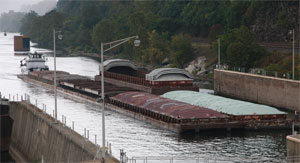Replacing the antiquated Lower Monongahela River Locks and Dams will likely be one of the waterway projects jumpstarted by a 9-cent increase in the barge diesel user fee.
Beginning in April 2015, the fee will increase from 20 cents per gallon to 29 cents as part of a broad restructuring of inland waterways planning and appropriations.
Changes in funding will generate more money for other inland waterway improvements that have been stalled due to the Olmsted Locks and Dam project, the largest and most expensive inland water navigation installation ever built in the United States. Budgeted at $775 million, the project has extended years beyond the original construction estimates.
“The problem was that every dollar going into the trust fund (the Inland Waterways Trust Fund, or IWTF) was going out the door to pay for Olmsted,” said Deborah Colbert, senior vice president for the Waterways Council Inc.
The user fees are deposited into the IWTF and matched by federal dollars. Under the recently passed Water Resources Reform and Development Act (WRRDA), the federal funding match was increased from 50 percent to 85 percent.
The user fee increase is expected to raise an additional $80 million each year. Thanks to the increasing federal matches, more projects are likely to receive funds. The change in the federal share will add about $105 million for lock and dam construction, maintenance and repair.
The fee increase and other changes were the result of a broad effort to improve the management of waterways infrastructure to handle forecast increases in traffic, due in part to record grain harvests. Shippers as well as barge operators joined forces to lobby for changes to the system.
The Lower Mon project will reconfigure Locks and Dams 2, 3 and 4 on the Monongahela River in southwestern Pennsylvania, the three oldest currently operating navigation facilities on that river. The project will create a 30-mile unimpeded section of river between Braddock and Charleroi at an authorized 9-foot navigation depth, according to the U.S. Army Corps of Engineers. The federal budget for fiscal year 2015 includes $9 million for the project.
“That’s a great influx of money for that project, and we’re finally seeing that some of these projects will continue on a more efficient level,” Colbert said.
Other projects awaiting additional funding include the Kentucky Lock Addition and the Chickamauga Lock, both on the Tennessee River, and the Emsworth Dam and Markland Lock and Dam rehabilitation projects on the Ohio River.
With additional funding available, the Navigation and Ecosystem Sustainability Program (NESP) may move forward as well, Colbert said. The project has been authorized but no money appropriated to build new locks on the upper Mississippi and Illinois rivers.
“The upper Mississippi system needs to be ready to handle the forecasts of large harvests downriver and moving all the agricultural inputs like fertilizer upriver,” Colbert said.
Although only about 300 commercial operators are subject to the diesel user fee, the industry stepped up to the plate to pay higher fees for new construction and rehabilitation.
“This is a system that has multiple beneficiaries, from recreational anglers and boaters to those who benefit from hydropower,” Colbert said. “We feel like the trust fund works properly but it needed more money to be raised, and we were happy to continue that.”

